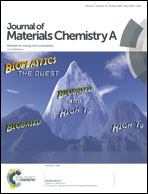Controlled surface decomposition derived passivation and energy-level alignment behaviors for high performance perovskite solar cells†
Abstract
Interface engineering is a crucial strategy to improve the performance of the perovskite solar cells. The introduction of excess PbI2 with simple mixing method is widely used, but unfortunately its underlying mechanism is still unclear. The main reason is the lack of direct evidence with precise control of the PbI2 distribution. Herein, a program-controlled pulsed H2O vapor exposure/purge method was developed to evenly generate thin PbI2 layer on the film surface. Based on this method, it was found that different PbI2 locations play a different effects on the photovoltaic performance of the perovskite solar cells. In the normal device structure, the performance improvement is owing to the passivation effect, while in the inverted device structure, the energy level alignment plays a more dominant role. The discoveries based on the PbI2 location controllable method are conducive to our new understanding of the traditional PbI2-rich system and thus can be a direction towards highly efficient perovskite solar cells.



 Please wait while we load your content...
Please wait while we load your content...